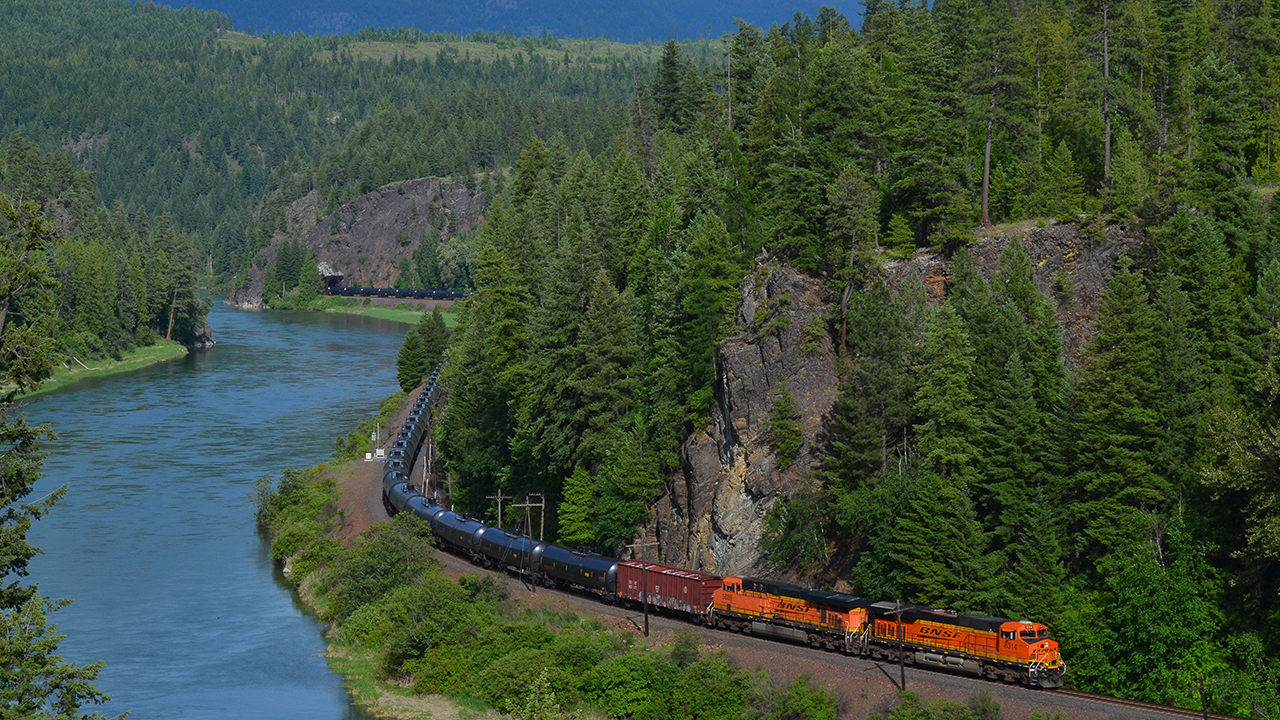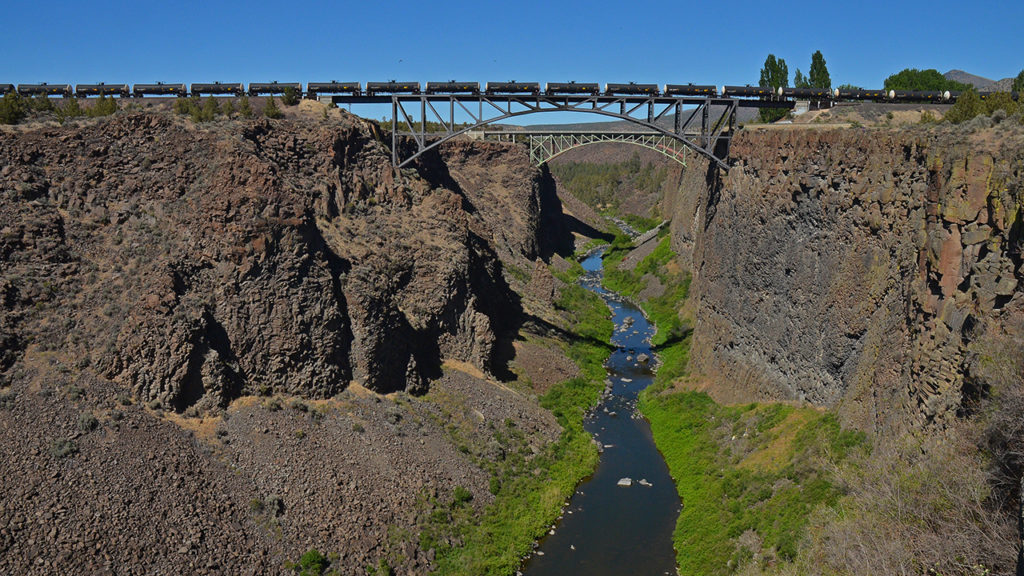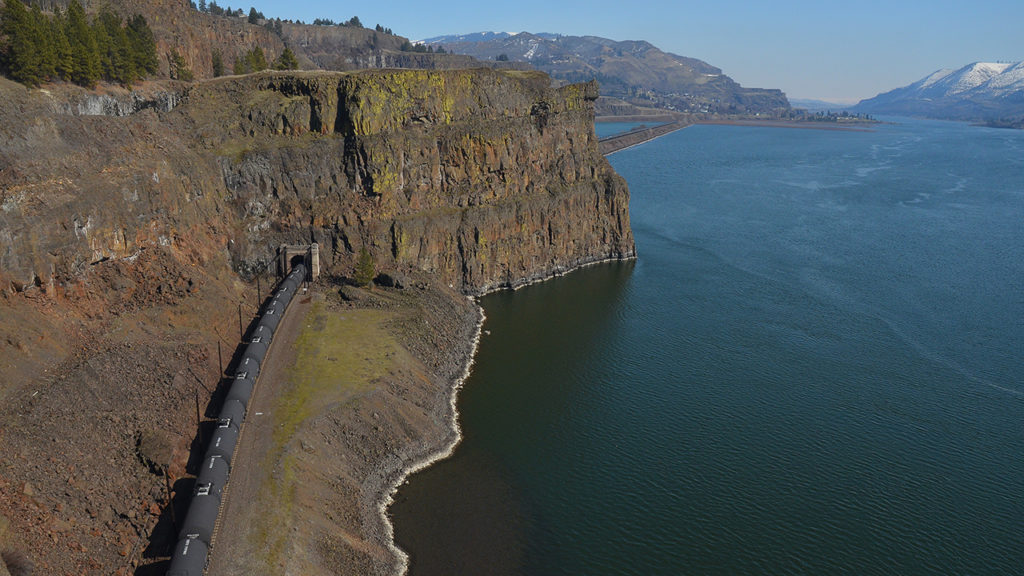
Water By Rail a No-Go for Now
Written by Bruce E. Kelly, Contributing Editor
Water trains could be handled much the same way as this BNSF oil train following the Kootenai River near Crossport, Idaho, during its journey of more than 1,500 miles to the West Coast. Bruce Kelly photo
Forty years ago, in September 1983, Southern Pacific launched a new service to haul crude oil from well sites in central California to a refinery south of Los Angeles. Some called it a “pipeline on rails.” Others referred to it as “the Oil Cans.” They were unit trains of nearly 80 cars loaded with petroleum, traveling some 175 miles over steep mountain grades, across open desert, and in later years along the Pacific Coast, at considerable expense in motive power, manpower and fuel given the nine or ten locomotives involved in each trip, some of them positioned at mid-train with a second crew on board.
After Union Pacific inherited this operation through its merger with SP in 1996, another 15 years would pass before the rail industry expanded the concept to a previously unimaginable scale by providing the means for oil producers to connect their new generation of extraction sites to refineries and export docks throughout North America. Crude by Rail (CBR) was born, and Class I railroads began to find themselves transporting 100-car (give or take) unit trains of crude not just hundreds of miles, but as much as 2,000 miles from places like North Dakota and Alberta to receiving terminals as far away as California and the Gulf and East coasts.
It’s often said that necessity is the mother of invention—which explains why the rail and energy sectors were so quick to invest billions of dollars on new track, facilities, rolling stock and personnel to meet the needs of an energy-hungry world.
But in this day and age, money is the master of conception. Which explains why the almighty dollars that eagerly answered the call to move oil across vast distances have not even picked up the phone in response to the Western U.S.’s desperate cry for water—a cry that seems momentarily muted following months of record-setting precipitation.
No one should think that trains could somehow transport enough water to enough places to remedy all drought. In all practicality, it would only be a matter of single cars, multi-car blocks or entire unit trains delivering water to a select number of communities and farms that have proximity to rail.
Almost nine years ago, Matt Rose, who was then Chairman, President and CEO of BNSF Railway, said that his company had “an initiative on Water by Rail.” Rose further explained, “We have looked at it several times and haven’t quite seen the economics work, but it might in the future.”
Plenty of Water, But Not Where It’s Needed

Railway Age first touched on Water by Rail (WBR) in 2014, and examined it more extensively in August 2015. The history remains the same: WBR has been performed in the past in the U.S. and elsewhere around the world, and it continues to happen in the 21st century in places like India and Australia. What has changed in recent years is that CBR traffic has declined, and some of that oil-related infrastructure and equipment is no longer generating the kind of revenue that it was built for.
Meanwhile, the drought situation in much of the Western U.S. has not gone away. Despite receiving heavy snow and rain during the winter of 2022-23, California lacks sufficient infrastructure for water catchment and storage. Much of the state’s recent precipitation flowed directly into the sea, and will continue to do so while mountain snowpack thaws—and this at a time when the Biden Administration has asked several Southwestern states to voluntarily cut back their use of Colorado River water. Having missed a Jan. 31, 2023, deadline to submit their plans for compliance, those states could end up facing federally imposed water restrictions at some point in the future.
In August 2022, the U.S. Department of the Interior announced, “President Biden’s Bipartisan Infrastructure Law makes a historic $8.3 billion investment to address water and drought challenges and invest in our nation’s western water and power infrastructure.” DOI also said, “Additionally, the recently passed Inflation Reduction Act includes $4 billion in funding specifically for water management and conservation efforts in the Colorado River Basin and other areas experiencing similar levels of drought.” Railway Age reached out to the DOI asking if any of these water/drought related projects have moved forward, and whether a small percentage of that funding could be allocated toward even a single WBR trial run. DOI did not respond.
With the federal government showing no signs of advancing new methods for transporting water from where it’s in abundance to where it’s desperately needed, some have made attempts at launching WBR on a grassroots level. In 2019, Minnesota-based Progressive Rail, which operates short lines in seven states, filed a preliminary application with the Minnesota Department of Natural Resources to drill two wells on company-owned property and extract as much as 500 million gallons of water annually for shipment to the Southwest. PR said it would partner with Water Train, headquartered in White City, Ore., for use of 26,000-gallon tank cars assembled into unit trains. Neither company has indicated any success at putting this proposal into action.
Likewise for California Western Railway (CWR) owner Mendocino Railway, whose president, Robert Pinoli, presented a plan in 2021 to transport as many as eight 25,000-gallon tank cars of water daily from Willits to Fort Bragg, Calif. Trucks would then ferry the water south to the drought-stricken coastal community of Mendocino. According to one published report, the water hauled by train would cost Mendocino consumers just over 20 cents per gallon vs. the 17 cents per gallon being charged under existing truck services, but the rail deliveries “would probably be much bigger and more dependable.” Local civic officials turned down the water train offer.
Ironhorse Permian Basin, which owns a large rail terminal near Artesia, N.Mex., handles unit trains of frac sand, pipe and occasional oil for that region’s crude and natural gas industries. It also owns wells from which water has been trucked to drilling sites. IPB CEO Kyle Ramage says his company received state permits in 2016 that would have enabled the shipment of roughly three unit trains of water per week. More recently, Ramage said, “I can’t imagine any railroad would not want to do it if they were being compensated, but it is still a far-off vision because of the costs of such an endeavor. On our side, we would want a long-term contract to build or allow to be built the needed infrastructure to accomplish the loading of water.”
Railroads Willing to Explore WBR

America’s two largest Class I railroads have expressed willingness to haul WBR for anyone who will pay the cost. Union PacificSenior Manager-Communications Mike Jaixen tells Railway Age, “It is premature to speculate on whether shipping water by rail is feasible; however, we always listen to our customers to better understand their unique business needs and challenges, and where possible, provide a solution that makes sense.”
BNSF Vice President-Corporate Relations Zak Andersen says, “Although we have not recently had any customers ask us about transporting water by rail, we have looked at it several times over the years.” As for BNSF possessing the route capacity to handle WBR, Andersen says, “A lot would depend on the O/D (origin/destination) and what part of our network it would impact. But again, we are always looking for new and creative ways to grow with our customers. If there was any interest in transporting water by rail, we would be happy to explore it.”
UP and BNSF declined to speculate on prices for moving WBR. However, one former railroad official tells Railway Age, “You can think of it like average cost per unit if moving non-hazmat stuff via tank car. Average revenue per car is probably in the $4,000 range. Of course, single car vs. unit trains will be different.”
Government Moves Slower than Industry on Drought Relief
The U.S. Department of the Interior and U.S. Bureau of Reclamation declined comment about funding or feasibility for WBR under federal drought-relief auspices. Drought-stricken California, however, offered the following opinions. Akiela Moses with the Public Affairs Office of the California Department of Water Resources tells Railway Age, “In considering the feasibility of a multi-state water haulage system, whether by truck or by rail, the extraordinary costs would present significant obstacles when compared to other potential strategies and would offer short-term benefits for a drinking water shortage.” Moses says that state agencies are already providing “emergency bulk and bottled water to households whose private residential wells have gone dry because of drought or whose water is too contaminated to drink.”
Further downplaying California’s outlook on WBR as a drought solution, Moses says, “For larger-scale drinking water outages, such as a public water system, provision of bottled water is only a temporary measure until an emergency project such as drilling a new well, interconnecting with another water system or constructing an emergency pipeline can be completed.”
Therein lies the stark difference between CBR and WBR. When pipelines, emergency or otherwise, were not available to connect new sources of oil to market, oil producers reached immediately for rail. Though their numbers have declined, unit trains of crude still travel hundreds or thousands of miles in North America on a routine basis. Much of that CBR rolls past the same forests, farms and communities that lay parched in summer, and where streams, wells and aqueducts often run dry.
Meanwhile, billions of gallons of fresh water pour out of the Columbia River into the Pacific every hour, no matter what season or climate. And no one in political or corporate power seems willing to pose the bold idea of capturing even a fraction of it and transporting it to drought-stricken populations. New pipelines would take many years to design, permit and build. But it would take only months to put the first WBR corridor into service. However, the way Matt Rose summed it up late last year, “I think it’s a long putt, given the economics.”
Some Western reservoirs have been replenished by recent rainfall. Others, however, remain precariously low, including Lake Mead, which is America’s largest reservoir by volume and responsible for supplying water to more than 24 million people. In March 2023, NOAA (National Oceanic and Atmospheric Administration) announced that winter snow and rain have “wiped out exceptional and extreme drought in California for the first time since 2020, and is expected to further improve drought conditions this spring.” Meanwhile, NOAA said that drought conditions are expected to “continue or worsen” this year in other states from Oregon to Arizona to western Texas.
For the foreseeable future, the prospects for trains to haul water for drought relief in the U.S. appear about as uncertain as the prospects and predictions for water itself.

Bruce Kelly has produced photography and journalism for rail publications since 1982, with more than 120 feature articles and hundreds of news stories, reviews, and editorial commentaries to date. Nearly 2,000 of his photographs have appeared in railway magazines, books, calendars, annual reports, and advertising. He was Associate Editor of Railfan & Railroad from 1988 to 1996. Since 1996, he has worked in the digital prepress department of Idaho’s largest commercial printing company. Over the past 30 years, Kelly’s photography has been frequently featured on the front cover and inside pages of Railway Age.



